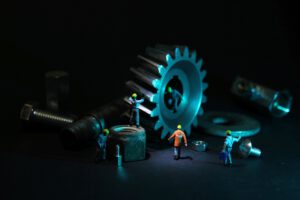
Maintenance work or total breakdown – sewer renovation blog
This blog is temporarily out of service for maintenance…
Thankfully that’s not the case!
But we want to use today’s post to draw your attention to the topic of maintaining and cleaning machinery and equipment:
Our customers have had problems on their building sites on several occasions this year alone because the equipment they were using wasn’t working properly.
In an ideal scenario the team on the building site will notice this quickly – the fault is easy to find and rectify or the problem slows down the renovation process to only a minimum extent; the building site continues to operate, even if delayed slightly.
But the machine might suffer a complete breakdown, overheat, etc. and it might not be possible to find and/or repair the fault – a new machine has to be sourced.
In the worst case, employees might even end up injured and that’s not something anybody wants to experience, is it?
Take this example from the beginning of the year:
a client got in touch with our technicians because our Flex 3D (DN 150; 5.5mm) wouldn’t expand, despite applying 0.9 bar pressure to the liner. So our application engineer Andreas drove to the renovation team to have a look at the whole thing. The fault wasn’t immediately obvious, which is why he took the remaining 17m of the liner used with him – a material fault was assumed at first.
The relevant tests were initiated, but nothing conspicuous came to light. Even at just 0.4 bar the Flex 3D did not cause any issue – neither in cold, non-impregnated condition, nor while warm and resin-impregnated.
Then we got another call from the customer: there were also problems installing the point liner, and these weren’t able to be resolved by us walking them through it over the phone either.
Andreas visited the team again a few days later and a test track was set up. The preparation of the materials, etc. went very well, until finally the compressor kicked in. It worked and worked but still there was barely any change visible on the packer. After much time spent querying what was wrong, finally it was set to 1.8 bar… the problem finally became clear: on closer inspection it emerged all of the displays/valves were defective and therefore the air pressure reading was incorrect. Instead of the 1.8 bar assumed, the actual level was just 0.4 bar.
Thankfully all that happened here was a delay in completing the renovation, but this was extremely exasperating as this could absolutely have been avoided had it simply been for the regular care and maintenance of the equipment used.
Care and maintenance comprise a number of steps.
Dirt and grime should be removed from machinery and equipment after every use. This cleaning may need to be more extensive depending on the equipment: e.g. certain parts may need to be removed. You can find information on this in the user manuals for the devices; you will also find information on components that may not need to be cleaned after every use, but for example every ten uses/every two weeks.
In addition, the condition of the machine and its components should be checked periodically in order to identify any problems early on – you can usually find instructions in the manuals for this as well.
If you can’t find a maintenance and care plan, especially for older machines, here are a few tips for you:
- Collect data
Make a list of the individual parts of the machine – which ones need to be lubricated, which ones get dirty quickly, which ones are exposed to high pressure, etc.
What can and should be checked? - Make an overview
Once all components have been listed, it is important to define what needs to be checked and how often. What needs to be topped up, what are the steps, etc.
Pictures can help here, too. - Define responsibilities
Who has to carry out the maintenance and care? Is this a fixed person or is everyone responsible for their own machines? Should care and maintenance be divided so each user automatically takes care of it and maintenance runs centrally? - Practical implementation
Ultimately, everything that is set out and written down has to be tested in practice. Are the intervals sufficient? Am I cleaning everything I need to? Has the performance of the machine changed? - Adjustments
Based on step 4: What do I need to adjust to make sure the device remains in good condition in the long term? What can I adjust, add to or get rid of?
Proper and regular care and maintenance of your equipment is an important prerequisite for optimal work processes. While this naturally requires investing time and money (in the form of one care product or the other), it is definitely worth it in the end. You will get more out of your devices for longer, they will run reliably and if something really does become defective or worn, you will notice it in time.
Equipment that comes from us always comes with appropriate maintenance instructions – if you still need help, or simply want up-to-date information, please get in touch with us – we would be happy to send you up-to-date information and instructions. Experience goes a long way here!
After all, we want you to be satisfied and enjoy your equipment for a long time to come!
Tip: In our online academy you’ll find a course on “Cleaning and lubricating the RENSSI spiral”. Let us know if you would like more guides – you can add a comment here if you like!
Until next time,
the team at Bodenbender
